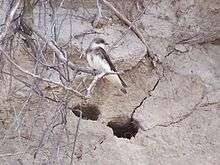Riparia
| Riparia | |
|---|---|
 | |
| Sand martin (Riparia riparia) | |
| Scientific classification | |
| Kingdom: | Animalia |
| Phylum: | Chordata |
| Class: | Aves |
| Order: | Passeriformes |
| Family: | Hirundinidae |
| Subfamily: | Hirundininae |
| Genus: | Riparia T. Forster, 1817 |
| Species | |
|
R. paludicola | |
Riparia is a small genus of passerine birds in the swallow family. The genus means "of the riverbank"; it is derived from the Latin ripa "riverbank".[1]
These are small or medium-sized swallows, ranging from 11–17 cm in length. They are brown above and mainly white below, and all have a dark breast band.
These species are closely associated with water. They nest in tunnels usually excavated by the birds themselves in a natural sand bank or earth mound. They lay white eggs, which are incubated by both parents, in a nest of straw, grass, and feathers in a chamber at the end of the burrow. Some species breed colonially.
The cosmopolitan sand martin is almost completely migratory, breeding across temperate Eurasia and North America and wintering in the tropics. The other species are partial migrants or resident.
Riparia martins, like other swallows, take insects in flight over water, grassland, or other open country.
Species
Extant Species
There are six species. In taxonomic order, they are:
| Image | Scientific name | Common name | Distribution |
|---|---|---|---|
.jpg) | R. paludicola (Vieillot, 1817) | brown-throated martin | Africa |
.jpg) | R. chinensis (J.E. Gray, 1830) | grey-throated martin | Tajikistan, Afghanistan and Indian subcontinent to southern China, Taiwan, and the northern Philippines |
| R. congica (Reichenow, 1887) | Congo martin | Congo River and its tributary, the Ubangi. | |
.jpg) | R. riparia (Linnaeus, 1758) | sand martin or bank swallow | southern Africa, South America and the Indian Subcontinent. |
| R. diluta (Sharpe & Wyatt, 1893) | pale martin or pale sand martin | central Asia to southeastern China | |
.jpg) | R. cincta (Boddaert, 1783 | banded martin | Africa from Cameroon and Zaire to Ethiopia south to the Cape in South Africa |
Fossil record
- Riparia minor (late Miocene of Polgardi, Hungary)[2]
References
| Wikimedia Commons has media related to Riparia. |
| Wikispecies has information related to Riparia |